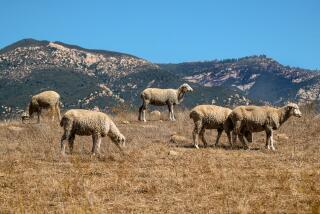Sheepish? Not these islanders
- Share via
SHELTER ISLAND, N.Y. — The signs went up two Fridays ago at George’s IGA market: “Sheep Voting Begins Monday.”
Stephanie Zinger, who is supervising the voting, posted the signs on her own three sheep, the bodies of which are painted in checkerboard patterns and the heads red, white and blue, with a 3 on one, a 5 on another and a 0 on the third. Placed together, they form “350,” the anniversary being celebrated by this island -- and the reason for the plywood sheep you see all over the place.
There’s one marked “Bah Bah Shop” in front of, naturally, the barbershop. Someone’s yard has a “Sheep Music” sheep with a toy sax in its mouth and notes on its body, said to be “Blue Baaaaa Ewe.” Even the local cops got into the act with a “Shark in Sheep’s Clothing,” painted like the “Jaws” creature that terrorized a fictional vacation isle.
For 15 months now, the sheep have served as a mass exercise of creative whimsy here -- and as a countrified counterpoint to the fancy “cow parades” staged in cities from Chicago to London.
In those extravaganzas, large fiberglass cows are sponsored by businesses, decorated by prominent artists and eventually auctioned off for charity. Their success has spawned a series of equally professional variations, from a Moose Parade in Toronto to a Gators Galore in Florida.
The Connecticut-based CowParade Holdings organization now peddles cow snow globes, coffee mugs and miniature ceramic copies of the most popular cows, which are sold at airport gift shops and on the Internet, at $17.99 for a 4-inch Gladiator Cow, say.
But Shelter Island has taken the concept back to the grass roots, so to speak. The local version was the brainchild of Patricia Shillingburg, a member of the 350th anniversary committee who saw the original Cow Parade in Chicago in 1999 and a Painted Ponies festival in Albuquerque. “A year later I was in the shower thinking what to do to unify the island,” she recalled. “And I thought: ‘sheep.’ ”
It was not feasible to have professionals decorate them, she decided, given that “in a city, you have lots of artists. Here we have two.” So the committee last year invited all residents to do-it-themselves, and not on molded three-dimensional sheep but thin cutouts, one version grazing and a second resting, both with two pointed legs made for sticking into the ground. The cost to get one at the general store, historical society or the florist? $25.
The result? More than 500 went up around the 8,000-acre island between the chic Hamptons and Long Island’s North Fork. Before long, you’d hear people asking at the Bliss general store, “Did you see what the ‘Sheep of the Week’ is?”
The local paper, the Shelter Island Reporter, began giving that honor to displays such as “Caught on the Lamb,” in the yard of Nick Panarella, a 69-year-old retired New York City detective. He created a policeman sheep painted blue -- with a gold badge and brass buttons on its uniform -- and a convict sheep in stripes, shackled with a chain around its neck and legs.
Another home erected a Lone Star Sheep decorated like the Texas flag, with cowboy boots and a red bandana. There was a Mermaid Sheep with a seashell bra and a Yellow Cab Sheep (“Veal Medallion”) painted like the medallion cabs that honk their horns in Manhattan, two hours west. A Golfer Sheep wore green plaid knickers, and a Fisherman Sheep toted a pole.
The island has 2,500 residents year-round, but the population grows several times that in summer, which was when a household at the north end used its sheep to send a message to the tourists who line up their cars for the ferry to Greenport: “Please Don’t Blaaaack Our Driveway.”
Other displays were more predictable -- like several Black Sheep. “Some are really good, some are awful,” said Lynn Thomson, a clerk in the general store who was amused also at what they were celebrating with all those sheep: “The anniversary of this place being invaded by the white man.”
Though Indians lived on Shelter Island well before, 1652 was when the English “settled” it in the person of Nathaniel Sylvester. Today, the grand dame of the island is Alice Fiske, 86, the widow of one of his descendants, Andrew Fiske, a Harvard-educated boatyard executive and 13th “lord of Sylvester Manor.”
The original manor house is long gone, but Mrs. Fiske still lives in its replacement, built in 1733. It was on her sprawling property that Shelter Island kicked off its anniversary festivities in May 2002 with a ceremony that included the singing of “God Bless America,” written by Irving Berlin in nearby Yaphank. Dressed in a flowing white dress and flowered bonnet, Mrs. Fiske strolled among the first plywood sheep erected -- 15 around her windmill, which used to grind grain for the island.
The island matriarch agreed that the sheep were a good choice as a “unifying theme” for the community in that “there once were big sheepherders here. They pickled the meat and sent it to the Caribbean for the workers who grew sugar cane for sugar molasses and rum.”
And how many real sheep does the island have these days?
“There aren’t any,” Fiske acknowledged. “There aren’t any four-legged ones now unless someone has one hidden.”
There are plenty of deer, however. “Too many,” she griped.
There have been occasional lapses of civic spirit since the sheep spread from her windmill to yards throughout the island. More than a few have vanished in the crime dubbed “sheep-napping,” but they usually resurfaced somewhere or got turned in to the police station.
“And that problem went away when the college kids went back to school,” noted Shillingburg, the woman who started it all.
On a recent day, the gray-haired Shillingburg, who sits on the zoning board, took a drive to point out her favorite sheep and see what new ones had surfaced, like a green “Lamb-a-Bean.”
“I wonder who did that. Not too many people know about the lima beans,” she said, explaining that her own father -- a lawyer and gentleman farmer -- had started a lima bean cooperative in the ‘50s, only to see the crop wiped out by hurricanes.
Shillingburg also stopped her SUV at a reminder of what a “Sheep Parade” might have looked like if Shelter Island had taken the big-city approach and put the project in the hands of professional artists. Sculptor Hap Bowditch set up his own display in a field using his trademark steel and metal shavings to create a Jesus-like shepherd tending two sheep with ragged coats that seem almost to be in motion -- and which make even the best of the island’s plywood creations look, well, amateurish.
“Do some look silly? Probably,” Bowditch says. “But I’m always happy for people to exercise some creativity, exercising the other side of their brains.”
Luckily for the islanders who have seen the sheep as a public test of wits, the sculptor’s works are not eligible for the voting to determine, after all these months, whose plywood sheep will take home the blue ribbons.
The organizers originally hoped to borrow from the big cow parades, which end with charity auctions. Chicago’s raised more than $3 million. In New York’s, a single cow, decorated with a Tiffany’s theme, went for $60,000.
The committee here was going to have the bidding at the beach party and concert Sept. 6 that will conclude Shelter Island’s 350th anniversary celebration.
“But most people wanted to keep their sheep,” said Zinger, a retired fourth-grade teacher.
That left the supermarket poll, which runs through Sunday. Zinger and others sifted through all the “Sheep of the Week” winners, and other submissions, to come up with three finalists in six categories: Patriotic, Recycled Materials, Sheep in Disguise, Artistic Interpretation, Fun, and Creative.
That category pits Panarella’s “Caught on the Lamb” display against the “Bah Bah Shop” sign and an “Electric Sheep,” which lights up.
“Oh, he cares,” said the former detective’s wife, Elke, who made it to the store, with her daughter, the second day of voting. “That’s two votes,” she declared.
There’s also a competition for sheep created by children 12 and under, “but between you and I, they all win,” Zinger said.
The six “adult” category winners will be displayed at the big beach party the Saturday after Labor Day. Zinger has not decided how to pick a grand prize winner but is leaning toward having partygoers drop pennies into cans in front of the contending sheep.
Then?
“And then,” Shillingburg said, “that’s the end of the sheep.”
More to Read
Sign up for Essential California
The most important California stories and recommendations in your inbox every morning.
You may occasionally receive promotional content from the Los Angeles Times.










